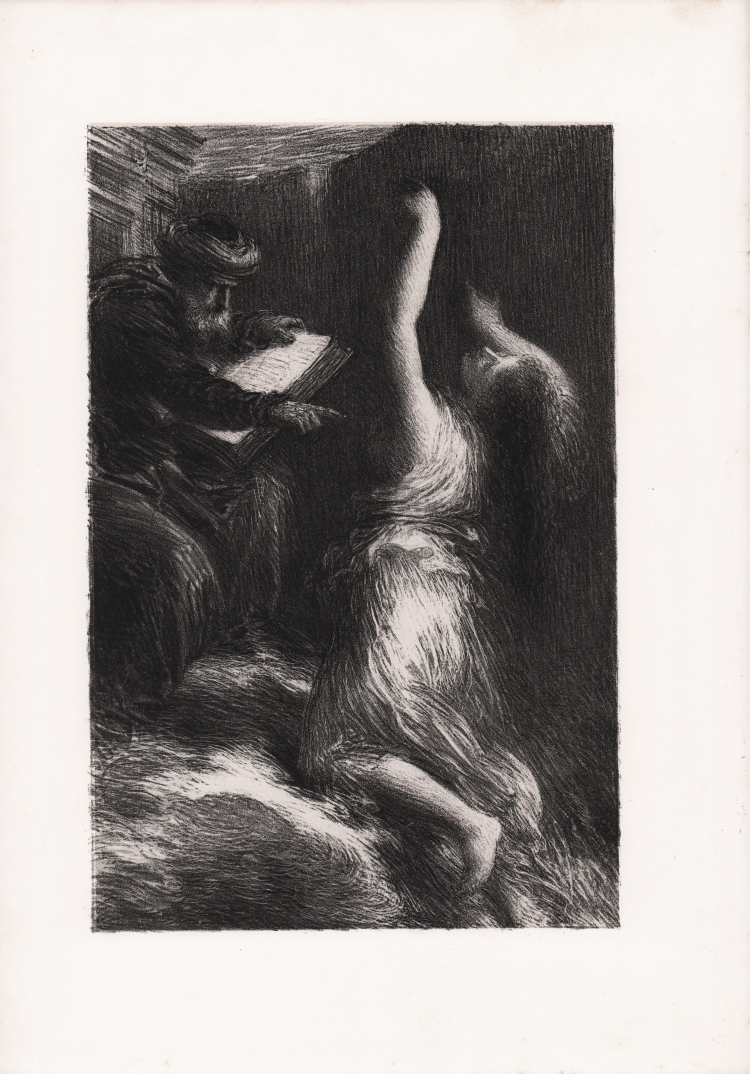



| Reference: | S42290 |
| Author | Henri FANTIN-LATOUR |
| Year: | 1886 |
| Measures: | 150 x 230 mm |


| Reference: | S42290 |
| Author | Henri FANTIN-LATOUR |
| Year: | 1886 |
| Measures: | 150 x 230 mm |
Lithograph, 1886.
The scene depicts an old magician, seated with open book on his knees, summons a female figure, who is kneeling at right, with her arms raised; scene from Wagner's opera 'Parsifal' and illustration to Jullien's 'Richard Wagner, sa vie et ses oeuvres' published in 1886 by Libraire de L’Art and printed by Lemercier et Cie (fl.1827–1899) in Paris.
Henri Fantin Latour (Grenoble 1836 - Buré, Orne, 1906) fu per qualche tempo, a Parigi, nello studio di G. Courbet; ma soprattutto si formò copiando al Louvre i maestri dei secc. 16º e 17º. Ammirò Manet e gli impressionisti, ma non fece mai parte del loro gruppo. Fu amico di J. Whistler, del quale condivise lo spirito di fine psicologismo che pervade le sue opere. Tra i suoi dipinti più noti, conservati al museo d'Orsay a Parigi: Omaggio a Delacroix (1864), Studio a Batignolles (1870), Angolo di tavola (1872), Intorno al pianoforte (1885), ritratti di gruppo di pittori, poeti, musicisti, in cui, come nei numerosi ritratti individuali, la personalità del modello è interpretata con profonda intimità. Una sensibile osservazione della realtà si ritrova anche nelle nature morte, mentre un mondo irreale traspare da alcuni dipinti (La notte, 1897, Parigi, museo d'Orsay) e in numerose litografie ispirate dalla sua passione per la musica di Schumann, Wagner e Berlioz.
References
Hédiard, Fantin-Latour: Catalogue de l'oeuvre lithographie du Maître 73; Fantin-Latour 1911 - Catalogue de l'Oeuvre Complet de Fantin-Latour 1325.
Henri FANTIN-LATOUR (Grenoble 1836 - Buré, Orne, 1906)
|
As a master of still-life painting, Henri Fantin-Latour is celebrated for his exquisitely detailed flower paintings and portraits of fellow intellectuals of the Parisian art world. Raised by a father who was an artist, Fantin-Latour began his artistic training from the early age of 10. He attended École des Beaux-Arts in Paris, where he developed his keen observation skills and dexterity by copying the works of old masters at Musée du Louvre.
With the skills acquired through the time spent at the Louvre, Fantin-Latour began to create portraits. He submitted them to the Salon in 1859 only to face rejection, which led him to direct his attention to floral still-life paintings. These works were first exhibited in London at the Royal Academy in 1864 and became extremely popular. His works in the 1870s were marked by purity and simplicity of composition, whereas his still-lifes in the 1880s were constructed with a more complex and detailed arrangement. With the extraordinary eye for detail that he had developed as a portrait painter, Fantin-Latour was able to depict each flower with remarkable specificity.
Despite the popularity he had gained from still-life paintings, Fantin-Latour continued to engage with portraits which eventually allowed him to establish himself in the market. Fantin-Latour gained prestige for his group portraits of fellow artists, such as Homage to Delacroix, 1864—currently in the collection of Musée d'Orsay, Paris—known for its exceptional virtuosity and swift brush strokes. The portraits highlight his relationship with other contemporaries, like Édouard Manet and James McNeill Whistler, with whom he shared artistic sensibilities.
In the last years of his life, Fantin-Latour focused on lithography, producing numerous prints of imaginative and mythological subjects. With a profound understanding of the technique, he elaborated the figures with various ranges of black and white tones. He continued to expand his practice in lithography until the end of his life. Fantin-Latour died in 1904.
|
Henri FANTIN-LATOUR (Grenoble 1836 - Buré, Orne, 1906)
|
As a master of still-life painting, Henri Fantin-Latour is celebrated for his exquisitely detailed flower paintings and portraits of fellow intellectuals of the Parisian art world. Raised by a father who was an artist, Fantin-Latour began his artistic training from the early age of 10. He attended École des Beaux-Arts in Paris, where he developed his keen observation skills and dexterity by copying the works of old masters at Musée du Louvre.
With the skills acquired through the time spent at the Louvre, Fantin-Latour began to create portraits. He submitted them to the Salon in 1859 only to face rejection, which led him to direct his attention to floral still-life paintings. These works were first exhibited in London at the Royal Academy in 1864 and became extremely popular. His works in the 1870s were marked by purity and simplicity of composition, whereas his still-lifes in the 1880s were constructed with a more complex and detailed arrangement. With the extraordinary eye for detail that he had developed as a portrait painter, Fantin-Latour was able to depict each flower with remarkable specificity.
Despite the popularity he had gained from still-life paintings, Fantin-Latour continued to engage with portraits which eventually allowed him to establish himself in the market. Fantin-Latour gained prestige for his group portraits of fellow artists, such as Homage to Delacroix, 1864—currently in the collection of Musée d'Orsay, Paris—known for its exceptional virtuosity and swift brush strokes. The portraits highlight his relationship with other contemporaries, like Édouard Manet and James McNeill Whistler, with whom he shared artistic sensibilities.
In the last years of his life, Fantin-Latour focused on lithography, producing numerous prints of imaginative and mythological subjects. With a profound understanding of the technique, he elaborated the figures with various ranges of black and white tones. He continued to expand his practice in lithography until the end of his life. Fantin-Latour died in 1904.
|